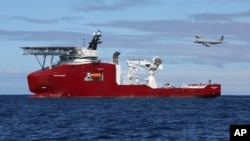BANGKOK —
The search area for Malaysia Airlines flight MH370 was further narrowed on Wednesday. That came as authorities confirmed that a vessel in the Indian Ocean had detected two more pings believed to be from the missing passenger jet's black boxes.
Officials are expressing more confidence that remnants of the Boeing 777 believed to be at the bottom of the southern Indian Ocean will be located.
A U.S. Navy device being towed by an Australian naval ship detected additional transmissions on Tuesday, after another pair of signals were captured days earlier.
The chief of the multi-national search coordination center in Perth, Australia, Angus Houston said, however, that it is still premature to declare that the plane’s location has been discovered.
"I believe we are searching in the right area but we need to visually identify aircraft wreckage before we can confirm with certainty that this is the final resting place of MH370," said Houston.
The search has now been narrowed to 75,000 square kilometers, an area nearly the size of the Czech Republic.
Officials on Wednesday announced that the earlier pings detected by the American towed pinger locator attached to the Ocean Shield vessel did not originate from "natural sources" and are consistent with those from flight data and cockpit voice recorders.
A top Australian military officer said a thick layer of silt on the seafloor could be muffling the black box transmissions, posing a further challenge to locating the wreckage at a depth few submarines would be able to reach.
Before it is feasible to deploy any unmanned underwater vehicles, authorities said, searchers really need to narrow the source of the sonar pings to within a few hundred meters. That is making the search a race against time as the batteries in the black boxes are already past their expected 30-day life.
The expensive search, which government officials in Australia and other countries acknowledge is costing millions of dollars per day, is turning into one of the most comprehensive such undertakings in history.
An attempt to retrieve parts of the plane and any human remains on the seabed some 4,500 meters deep would be an even more complex and expensive operation. It took nearly two years to recover the black boxes from the Air France jet that crashed in the Atlantic Ocean in 2009. Those flight recorders were found at a depth of nearly 4000 meters.
The flight from Kuala Lumpur on March 8 went off course from its route to Beijing and vanished, prompting an extensive search in what initially turned out to be the wrong areas.
Most of the 239 people aboard the plane were Chinese.
Officials are expressing more confidence that remnants of the Boeing 777 believed to be at the bottom of the southern Indian Ocean will be located.
A U.S. Navy device being towed by an Australian naval ship detected additional transmissions on Tuesday, after another pair of signals were captured days earlier.
The chief of the multi-national search coordination center in Perth, Australia, Angus Houston said, however, that it is still premature to declare that the plane’s location has been discovered.
"I believe we are searching in the right area but we need to visually identify aircraft wreckage before we can confirm with certainty that this is the final resting place of MH370," said Houston.
The search has now been narrowed to 75,000 square kilometers, an area nearly the size of the Czech Republic.
Officials on Wednesday announced that the earlier pings detected by the American towed pinger locator attached to the Ocean Shield vessel did not originate from "natural sources" and are consistent with those from flight data and cockpit voice recorders.
A top Australian military officer said a thick layer of silt on the seafloor could be muffling the black box transmissions, posing a further challenge to locating the wreckage at a depth few submarines would be able to reach.
Before it is feasible to deploy any unmanned underwater vehicles, authorities said, searchers really need to narrow the source of the sonar pings to within a few hundred meters. That is making the search a race against time as the batteries in the black boxes are already past their expected 30-day life.
The expensive search, which government officials in Australia and other countries acknowledge is costing millions of dollars per day, is turning into one of the most comprehensive such undertakings in history.
An attempt to retrieve parts of the plane and any human remains on the seabed some 4,500 meters deep would be an even more complex and expensive operation. It took nearly two years to recover the black boxes from the Air France jet that crashed in the Atlantic Ocean in 2009. Those flight recorders were found at a depth of nearly 4000 meters.
The flight from Kuala Lumpur on March 8 went off course from its route to Beijing and vanished, prompting an extensive search in what initially turned out to be the wrong areas.
Most of the 239 people aboard the plane were Chinese.












